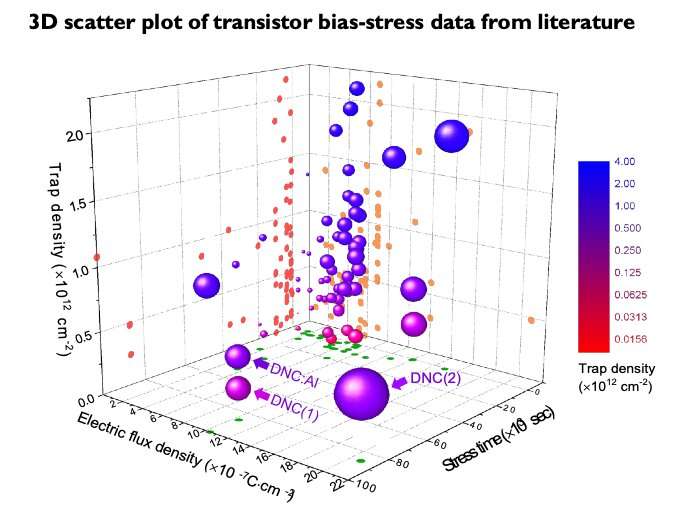January 20, 2020 feature
New organic-metal oxide transistors with high operational stability

Metal oxide thin-film transistors (TFTs), which are built by depositing thin films of an active metal oxide-based semiconducting material on a supporting substrate, have become widely used over the past few years, particularly in organic light-emitting diode displays. Most commercially available devices incorporating these transistors currently rely on metal oxides processed using physical vapor deposition techniques.
Recent studies suggest that there could be more cost-effective ways of fabricating TFTs, for instance, employing solution-based processes. So far, however, these processes have produced transistors with a low carrier mobility and unsatisfactory operational stabilities.
Researchers at King Abdullah University of Science and Technology (KAUST) in Saudi Arabia, University of Oxford in the U.K., and several other institutions worldwide have recently succeeded in fabricating oxide transistors with high electron mobility and operational stability using solution-phase deposition methods. In their study, featured in Nature Electronics, they used solution-processed multilayer channels made of ultrathin layers of indium oxide, zinc oxide nanoparticles, ozone-treated polystyrene and compact zinc oxide.
"We have been working toward resolving a longstanding issue that oxide-semiconductor thin-film transistors (TFTs) have faced since their invention: operational stability," Yen-Hung Lin, one of the lead researchers who carried out the study, told TechXplore. "This originates from the material properties—abundant non-stochiometric defects, which are responsible for the conductivity of oxide semiconductors. However, these defects are detrimental to device stability under long-hour continuous operation."
In a series of previous studies, the same team of researchers fabricated multilayer oxide-semiconductor TFTs that performed remarkably well, using different solutions. They also created a multilayer architecture that essentially mimics conventional high-electron-mobility transistors (HEMTs) to create an "energetic ladder."
In this multilayer architecture, high-mobility electrons are confined between indium oxide and zinc oxide, creating atomically sharp solution-processed, oxide-oxide heterointerfaces. In their recent paper, the researchers show that adding a UV-ozone treated few-nanometer-thin polystyrene layer to this structure can effectively passivate defects at the oxide-oxide heterointerfaces, which impaired the performance of their previously developed multilayer TFTs.

"We also incorporated zinc oxide nanoparticles or aluminium-doped zinc oxide nanoparticles in the polystyrene layer to further enhance device performance and operational stability," Lin explained.
The new approach to fabricate oxide TFTs introduced by Dr. Lin, Prof. Thomas Anthopoulos and their colleagues is simple and effective. One of its key advantages is that it relies on inexpensive solution-processable materials, including indium nitrate, zinc oxide powder, zinc oxide nanoparticles and aluminum-doped zinc oxide nanoparticles.
The TFTs can also be made on flexible substrates, such as polymers or paper, as the devices are fabricated at 200 degrees C. The researchers found that the resulting transistors have the highest operational stability reported in the literature so far under one of the toughest test conditions (i.e., 24-hour continuous operation with high electric flux density).
"We discovered an effective way to deliver a low-temperature, solution-grown, high-performance thin-film transistor with unprecedented operational stability by combining organic materials, which are often the go-to materials for flexible electronics, and oxide semiconductors," Lin said. "Indium gallium zinc oxide (IGZO), which is currently the incumbent material for thin-film transistors in the post-amorphous-silicon generation, is quickly replacing amorphous silicon as the main material for the global display industry, although it usually requires either a vacuum process or high temperature."
In the future, the new hybrid organic metal-oxide transistors introduced by Lin and his colleagues could greatly advance the development of flexible electronics. In fact, compared to other solution-processable materials, oxide semiconductors are easier to manufacture, often achieving better electrical performance than other competing technologies. For instance, oxide semiconductors are simpler to produce and perform better than solution-processed 2-D materials, which makes them more suitable for most low-end applications.
"In the future, we plan to extend the application of our multilayer organic-oxide semiconducting channels in other electronic and optoelectronic devices (e.g., radio frequency diodes, photodetectors) due to their high performance and operational stability," Lin said. "We also plan to fabricate transistors and integrated circuits using other scalable, high-throughput manufacturing techniques (e.g. printing or spraying), which could be used in numerous emerging technologies, such as flexible displays and biochemical sensors, among many others."
More information: Yen-Hung Lin et al. Hybrid organic–metal oxide multilayer channel transistors with high operational stability, Nature Electronics (2019). DOI: 10.1038/s41928-019-0342-y
Yen-Hung Lin et al. High Electron Mobility Thin-Film Transistors Based on Solution-Processed Semiconducting Metal Oxide Heterojunctions and Quasi-Superlattices, Advanced Science (2015). DOI: 10.1002/advs.201500058
Dongyoon Khim et al. Modulation-Doped In2 O3 /ZnO Heterojunction Transistors Processed from Solution, Advanced Materials (2017). DOI: 10.1002/adma.201605837
Hendrik Faber et al. Heterojunction oxide thin-film transistors with unprecedented electron mobility grown from solution, Science Advances (2017). DOI: 10.1126/sciadv.1602640
© 2020 Science X Network




















